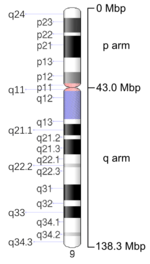Chromosome 9 (human)
| Chromosome 9 (human) | |
|---|---|
 Human chromosome 9 pair after G-banding. One is from mother, one is from father. | |
 Chromosome 9 pair in human male karyogram. | |
| Features | |
| Length (bp) | 138,394,717 bp |
| Number of genes | 1,742 |
| Type | Autosome |
| Centromere position | Submetacentric[1] |
| Identifiers | |
| RefSeq | NC_000009 |
| GenBank | CM000671 |

Ideogram of human chromosome 9. Mbp means mega base pair. See locus for other notation.
Chromosome 9 is one of the 23 pairs of chromosomes in humans. People normally have two copies of this chromosome, as they normally do with all chromosomes. Chromosome 9 spans about 138 million base pairs of nucleic acids (the building blocks of DNA) and represents between 4 and 4.5 percent of the total DNA in cells.
Identifying genes on each chromosome is an active area of genetic research. Because researchers use different approaches to predict the number of genes on each chromosome, the estimated number of genes varies. Chromosome 9 likely contains between 800 and 1,200 genes.
Genes
The following are some of the genes located on chromosome 9:
- ABO: ABO histo-blood group glycosyltransferases
- ACTL7A: encoding protein Actin-like protein 7A
- ADAMTS13: ADAM metallopeptidase with thrombospondin type 1 motif, 13
- ALAD: aminolevulinate, delta-, dehydratase
- ALS4: amyotrophic lateral sclerosis 4
- ASS: argininosuccinate synthetase
- CCL21: chemokine (C-C motif) ligand 21, SCYA21
- CCL27: chemokine (C-C motif) ligand 27, SCYA27
- C9orf58/AIF1L: encoding protein Allograft inflammatory factor 1-like
- C9orf78: encoding protein Uncharacterized protein C9orf78
- C9orf82: encoding protein Uncharacterized protein C9orf82
- C9orf91: encoding protein C9orf91
- C9orf135: encoding protein Chromosome 9 open reading frame 135
- COL5A1: collagen, type V, alpha 1
- ENG: endoglin (Osler-Rendu-Weber syndrome 1)
- FIBCD1: encoding protein Fibrinogen C domain containing 1
- FXN: frataxin
- GALT: galactose-1-phosphate uridylyltransferase
- GLE1L: Nucleoporin GLE1
- GRHPR: glyoxylate redasductase/hydroxypyruvate reductase
- IKBKAP: inhibitor of kappa light polypeptide gene enhancer in B-cells, kinase complex-associated protein
- MGC50722: Protein MGC50722, Uncharacterized Protein LOC399693
- TGFBR1: transforming growth factor beta, receptor type I
- TMC1: transmembrane channel-like 1
- TSC1: tuberous sclerosis 1
Diseases and disorders
The following diseases are some of those related to genes on chromosome 9:
- acytosiosis
- ALA-D deficiency porphyria
- citrullinemia
- chronic myelogenous leukemia (t9;22 - the Philadelphia chromosome)
- Diaphyseal Medullary Stenosis with Malignant Fibrous Histiosytoma (DMS-MFH, Hardcastle Syndrome)
- Ehlers-Danlos syndrome
- Ehlers-Danlos syndrome, classical type
- familial dysautonomia
- Friedreich ataxia
- galactosemia
- Gorlin syndrome or nevoid basal cell carcinoma syndrome
- hereditary hemorrhagic telangiectasia
- lethal congenital contracture syndrome
- nail-patella syndrome (NPS)
- nonsyndromic deafness
- nonsyndromic deafness, autosomal dominant
- nonsyndromic deafness, autosomal recessive
- OCD
- polycythemia vera
- porphyria
- primary hyperoxaluria
- Tangier's disease
- tetrasomy 9p
- thrombotic thrombocytopenic purpura
- trisomy 9
- tuberous sclerosis
- VLDLR-associated cerebellar hypoplasia
References
- Gilbert F, Kauff N (2001). "Disease genes and chromosomes: disease maps of the human genome. Chromosome 9". Genet Test. 5 (2): 157–74. doi:10.1089/109065701753145664. PMID 11551106.
- Humphray SJ, Oliver K, Hunt AR, et al. (2004). "DNA sequence and analysis of human chromosome 9". Nature. 429 (6990): 369–74. doi:10.1038/nature02465. PMC 2734081
 . PMID 15164053.
. PMID 15164053. - Wicking C, Berkman J, Wainwright B (1994). "Fine genetic mapping of the gene for nevoid basal cell carcinoma syndrome. Chromosome 9". Genomics. 22 (3): 505–11. doi:10.1006/geno.1994.1423. PMID 8001963.
- Mäkelä-Bengs P, Järvinen N, Vuopala K, Suomalainen A, Palotie A, Peltonen L (1997). "The assignment the lethal congenital contracture syndrome (LCCS) locus to chromosome 9q33-34". Am. J. Hum. Genet. 61 (suppl): A30.
| Wikimedia Commons has media related to Human chromosome 9. |
- ↑ "Table 2.3: Human chromosome groups". Human Molecular Genetics (2nd ed.). Garland Science. 1999.
This article is issued from Wikipedia - version of the 11/19/2016. The text is available under the Creative Commons Attribution/Share Alike but additional terms may apply for the media files.